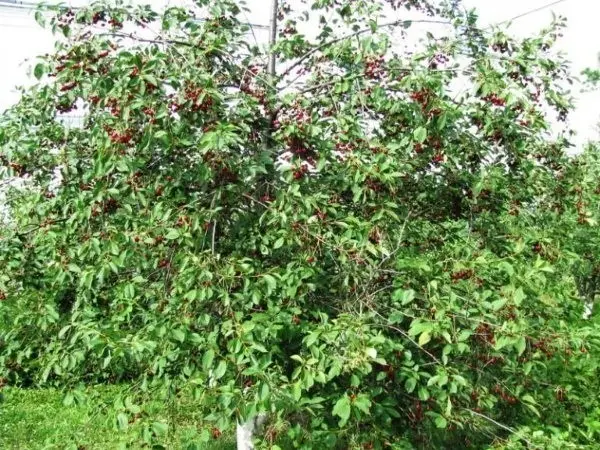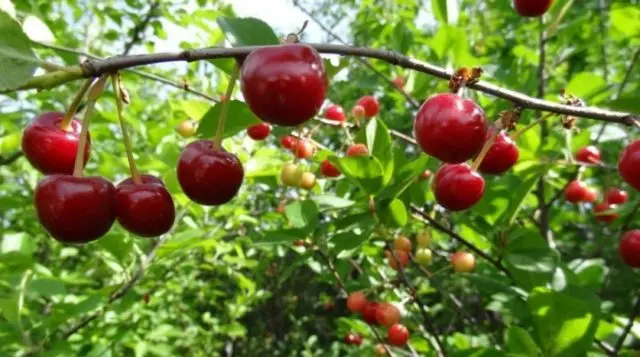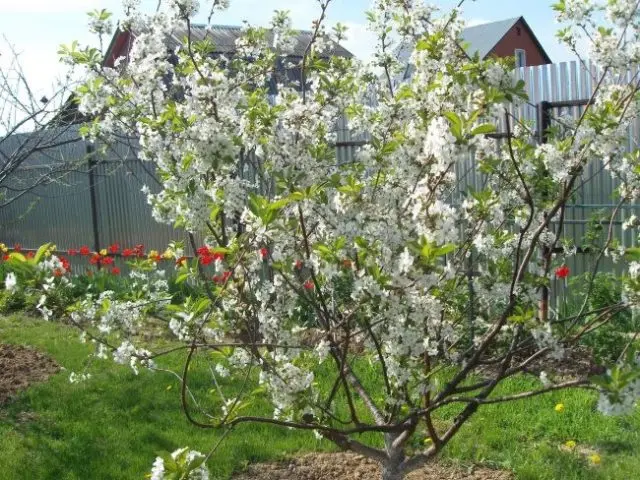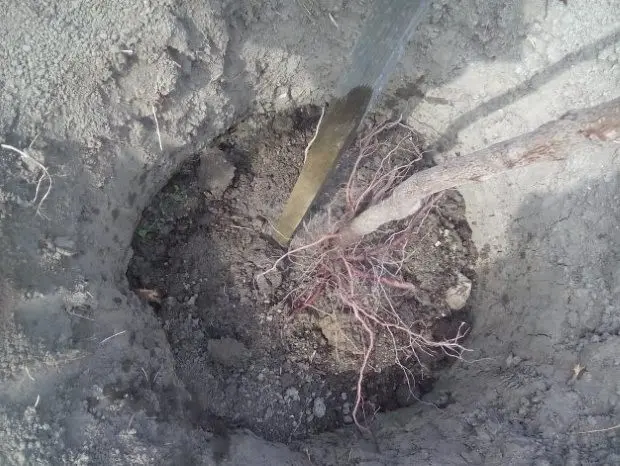Contents
Cherry Dawn of the Volga region is a hybrid bred as a result of crossing two varieties: Krasa Severa and Vladimirskaya. The resulting plant has high frost resistance, good disease resistance and small size. This cherry does not require pollinators.
Description of cherry Dawn of the Volga region
Compact trees with a trunk with a diameter of no more than 7-10 cm. At a height of about 1 m, it branches into two large branches. The density of the crown is low, the foliage is medium.
Height and dimensions of an adult tree
Adult cherry Zarya Volga region rarely reaches a height of more than 2,5 m. Moreover, even if stimulating pruning is carried out, it is not possible to obtain a greater value. Therefore, the plant is formed with a spherical medium spreading crown with a diameter of up to 2 m.

Appearance of the crown of the plant
Description of fruits
Cherry fruits Dawn of the Volga region are red. They have a flat round shape. The mass of berries is from 4 to 5 g.

Appearance of ripe cherry fruits Zarya Povolzhya
Tasting indicators of berries are high. They are rated 4,5 on a five-point scale. Berries do not crumble when ripe and are not baked in the sun.
Do I need a pollinator cherry Dawn of the Volga region
This variety is self-fertile. Does not need pollinators.
Main characteristics
In general, the Zarya Volga region cherry variety has balanced characteristics. It can be recommended for both beginners and experienced gardeners as a plant in the private sector. It is not recommended to use the Zarya Povolzhya cherry variety for commercial purposes, since the payback per unit area is less than that of most similar varieties.

Appearance of a flowering plant at the age of 5 years
Drought resistance, frost resistance
Frost resistance of the plant corresponds to the 4th zone. Cherry Dawn of the Volga region withstands frosts down to -30 ° C. In the Middle Strip, the plant does not need shelter.
The drought resistance of the Zarya Povolzhya cherry is average. It is not recommended to take breaks in watering for more than 10 days.
Productivity
The variety belongs to early ripening. Harvesting is carried out at the end of June. The yield is about 150 kg per hundred square meters. You can increase it for the Volga Dawn cherry by fertilizing. Fruiting occurs in the 4th year of the plant’s life.
Advantages and disadvantages
The positive properties of the variety include:
- high winter hardiness;
- compactness of the tree crown and its convenient shape;
- early maturation;
- self-fertility of the variety (theoretically, a cherry orchard can generally consist of a monoculture);
- excellent taste of fruits;
- their versatility.
Cherry variety Dawn of the Volga region has the following negative qualities:
- low resistance to fungal diseases;
- relatively low yield.
The last of the shortcomings is controversial. The absolute yields for Zarya Povolzhya cherries may not be high. But given the size of the crown and the compact placement of plants on the site, the declared figure of 1,5 kg per 1 sq. m is quite acceptable.
How to plant cherries Dawn of the Volga region
Planting a tree begins with the selection of seedlings. As such, planting material grown in the same region should be used. This ensures good survival of young plants.
Recommended dates
Depending on the condition of the acquired planting material, the timing of its landing in the ground is determined. It should be remembered that cherry seedlings of the Volga Dawn with an open root system should take root in spring or autumn. If the young plant is sold in a container, it can be planted at any time during the warm season.

Saplings of Dawn of the Volga region
It is believed that the best time for planting is the beginning of May, when the soil is already thoroughly warmed up. At this time of the year there will be good sap flow and good seedling growth rates. On the other hand, it is possible to carry out the autumn planting of the Volga Dawn cherry. In this case, the tree will be able to adapt better and the next year, having come out of dormancy, begin to develop in a “natural” way.
Site selection and soil preparation
Cherry Dawn of the Volga region requires a sunny area, located on a small hill. The ideal option would be the top of the southern slope, protected from the northern direction by a fence.
The plant loves sandy soil, a compromise option is loam. Acidity should be neutral. Too acidic soils are recommended to be limed with wood ash or dolomite flour. The introduction of these components is allowed during planting.
Landing algorithm
The depth of the pit for planting Zarya Povolzhya cherries should be about 50-80 cm. Ultimately, it depends on the level of groundwater. The higher it is, the larger the pit is recommended, since drainage will have to be laid on the bottom. Usually, gravel or small gravel is used as the latter.
The diameter of the pit depends on the size of the root system and should be 10-15 cm larger than it. Therefore, its recommended value is 60-80 cm.
Before planting in a pit, a nutrient mixture of the following composition is applied over the drainage:
- garden soil – 10 l;
- humus – 10 l;
- superphosphate – 200 g;
- potassium salt – 50 g.
At the same stage, you can add a lime component.
Previously, 5-6 hours before planting in the ground, it is recommended to soak the roots of young cherries in Epin or Kornevin. After the seedling settles in the stimulator, they start planting, which is carried out according to the following scheme:
- The nutrient mixture prepared in advance is poured into a hole dug for planting a tree.
- The top layer of the mixture is additionally mixed with ash or dolomite flour (if there is a need to reduce the acidity of the soil).
- A small mound is formed from the top layer of the mixture.
- A support is driven into the pit, next to it, in the center, a seedling is installed.
- The roots of the seedling are neatly and evenly distributed along the slopes of the mound.
- From above, the roots fall asleep to the ground level with the remnants of the soil mixture.
- Compact the soil around the young tree.
- After planting, young trees are watered (20 liters of warm water for each specimen).
At the end of planting, it is recommended to mulch a layer of soil around the tree.

Installation of cherry seedling Dawn of the Volga region in the pit during planting
Features of care
The first year, seedlings require a certain care procedure, without which it is likely that they will die or slow down in development. Care consists of timely watering, fertilizing and pruning.
Watering and fertilizing schedule
Watering is done as the soil dries out. Usually, a scheme is used in which one abundant watering is done after fairly large periods of time. In this case, the maximum rooting speed is achieved.
It is recommended to carry out this procedure 1 time in 7-10 days, depending on the weather and air humidity. The norm is 20 liters for one tree. If the level of natural precipitation is sufficient, artificial irrigation can be omitted.
For young trees, root top dressing is recommended. In the first half of the warm season (until June), nitrogen fertilizers should be applied, as they stimulate vegetation and the growth of green mass is plentiful.
After flowering, you can add superphosphate. Before wintering, it is recommended to use organic fertilizers in the form of humus or bird droppings, diluted in water.
Trimming
The formation of the correct spherical crown will require mandatory pruning of the tree. This procedure is carried out exclusively in spring (before bud break) or autumn (after leaf fall). In doing so, the following actions are carried out:
- form the appearance of the crown in the form of a ball or an ellipse elongated upwards;
- prune damaged or diseased shoots;
- remove branches growing at sharp angles into the crown.
Usually, cropping is done using a sector. Sections with a diameter of more than 10 mm are treated with garden pitch.
Preparation for winter
As such, there is no preparation of the tree for winter. Since the plant is able to withstand temperatures up to -30 ° C, no shelter is needed for the Volga Dawn cherry.
Diseases and pests
Of the plant’s vulnerabilities to diseases, only various fungal infections can be noted. The methods of their treatment and prevention are standard: treatment with copper-containing preparations. The first procedure is carried out with a solution of 1% Bordeaux mixture even before the buds open. The second – about a week after fruit set. In the event of white rot or powdery mildew, it is recommended to remove damaged wood fragments.
Of the pests, rodents (for example, hares) can deliver the greatest concern, which eat the bark at the bottom of the trees. To combat this phenomenon, it is necessary to whitewash tree trunks with lime to a height of about 1 m at the end of autumn.
Feathered pests (for example, starlings) show no interest in the Volga Dawn cherry, so there is no need to set up any traps in the form of nets or install scarecrows on the site during fruit ripening.
Conclusion
Cherry Dawn of the Volga region is a frost-resistant variety adapted for cultivation in the Middle Strip. For its compact size, this variety has a relatively good yield, as well as good performance. With the timely organization of preventive measures, the variety is practically immune to diseases.









